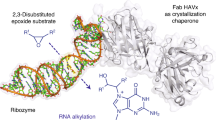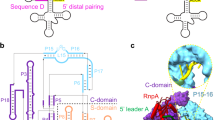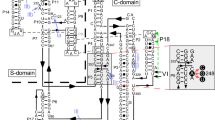Abstract
The field of small self-cleaving nucleolytic ribozymes has been invigorated by the recent discovery of the twister, twister-sister, pistol and hatchet ribozymes. We report the crystal structure of a pistol ribozyme termed env25, which adopts a compact tertiary architecture stabilized by an embedded pseudoknot fold. The G-U cleavage site adopts a splayed-apart conformation with in-line alignment of the modeled 2′-O of G for attack on the adjacent to-be-cleaved P-O5′ bond. Highly conserved residues G40 (N1 position) and A32 (N3 and 2′-OH positions) are aligned to act as a general base and a general acid, respectively, to accelerate cleavage chemistry, with their roles confirmed by cleavage assays on variants, and an increased pKa of 4.7 for A32. Our structure of the pistol ribozyme defined how the overall and local topologies dictate the in-line alignment at the G-U cleavage site, with cleavage assays on variants revealing key residues that participate in acid-base-catalyzed cleavage chemistry.
This is a preview of subscription content, access via your institution
Access options
Subscribe to this journal
Receive 12 print issues and online access
$259.00 per year
only $21.58 per issue
Buy this article
- Purchase on Springer Link
- Instant access to full article PDF
Prices may be subject to local taxes which are calculated during checkout






Similar content being viewed by others
References
Jimenez, R.M., Polanco, J.A. & Luptak, A. Chemistry and biology of self-cleaving ribozymes. Trends Biochem. Sci. 40, 648–661 (2015).
Weinberg, Z. et al. New classes of self-cleaving ribozymes revealed by comparative genomics analysis. Nat. Chem. Biol. 11, 606–610 (2015).
Prody, G.A., Bakos, J.T., Buzayan, J.M., Schneider, I.R. & Bruening, G. Autolytic processing of dimeric plant virus satellite RNA. Science 231, 1577–1580 (1986).
Hutchins, C.J., Rathjen, P.D., Forster, A.C. & Symons, R.H. Self-cleavage of plus and minus RNA transcripts of avocado sunblotch viroid. Nucleic Acids Res. 14, 3627–3640 (1986).
Saville, B.J. & Collins, R.A. A site-specific self-cleavage reaction performed by a novel RNA in Neurospora mitochondria. Cell 61, 685–696 (1990).
Perreault, J. et al. Identification of hammerhead ribozymes in all domains of life reveals novel structural variations. PLOS Comput. Biol. 7, e1002031 (2011).
Webb, C.H., Riccitelli, N.J., Ruminski, D.J. & Luptak, A. Widespread occurrence of self-cleaving ribozymes. Science 326, 953 (2009).
Buzayan, J.M., Gerlach, W.L. & Bruening, G. Non-enzymatic cleavage and ligation of RNAs complementary to a plant virus satellite RNA. Nature 323, 349–353 (1986).
Fedor, M.J. Structure and function of the hairpin ribozyme. J. Mol. Biol. 297, 269–291 (2000).
Winkler, W.C., Nahvi, A., Roth, A., Collins, J.A. & Breaker, R.R. Control of gene expression by a natural metabolite-responsive ribozyme. Nature 428, 281–286 (2004).
Watson, P.Y. & Fedor, M.J. The ydaO motif is an ATP-sensing riboswitch in Bacillus subtilis. Nat. Chem. Biol. 8, 963–965 (2012).
Webb, C.H. & Luptak, A. HDV-like self-cleaving ribozymes. RNA Biol. 8, 719–727 (2011).
Lilley, D.M. The Varkud satellite ribozyme. RNA 10, 151–158 (2004).
Martick, M. & Scott, W.G. Tertiary contacts distant from the active site prime a ribozyme for catalysis. Cell 126, 309–320 (2006).
Rupert, P.B. & Ferre-D'Amare, A.R. Crystal structure of a hairpin ribozyme-inhibitor complex with implications for catalysis. Nature 410, 780–786 (2001).
Rupert, P.B., Massey, A.P., Sigurdsson, S.T. & Ferre-D'Amare, A.R. Transition state stabilization by a catalytic RNA. Science 298, 1421–1424 (2002).
Klein, D.J. & Ferre-D'Amare, A.R. Structural basis of glmS ribozyme activation by glucosamine-6-phosphate. Science 313, 1752–1756 (2006).
Cochrane, J.C., Lipchock, S.V. & Strobel, S.A. Structural investigation of the GlmS ribozyme bound to Its catalytic cofactor. Chem. Biol. 14, 97–105 (2007).
Ferré-D'Amaré, A.R., Zhou, K. & Doudna, J.A. Crystal structure of a hepatitis delta virus ribozyme. Nature 395, 567–574 (1998).
Ke, A., Zhou, K., Ding, F., Cate, J.H. & Doudna, J.A. A conformational switch controls hepatitis delta virus ribozyme catalysis. Nature 429, 201–205 (2004).
Suslov, N.B. et al. Crystal structure of the Varkud satellite ribozyme. Nat. Chem. Biol. 11, 840–846 (2015).
Doherty, E.A. & Doudna, J.A. Ribozyme structures and mechanisms. Annu. Rev. Biochem. 69, 597–615 (2000).
Cochrane, J.C. & Strobel, S.A. Catalytic strategies of self-cleaving ribozymes. Acc. Chem. Res. 41, 1027–1035 (2008).
Ferré-D'Amaré, A.R. & Scott, W.G. Small self-cleaving ribozymes. Cold Spring Harb. Perspect. Biol. 2, a003574 (2010).
Lilley, D.M. Mechanisms of RNA catalysis. Phil. Trans. R. Soc. Lond. B 366, 2910–2917 (2011).
Roth, A. et al. A widespread self-cleaving ribozyme class is revealed by bioinformatics. Nat. Chem. Biol. 10, 56–60 (2014).
Eiler, D., Wang, J. & Steitz, T.A. Structural basis for the fast self-cleavage reaction catalyzed by the twister ribozyme. Proc. Natl. Acad. Sci. USA 111, 13028–13033 (2014).
Liu, Y., Wilson, T.J., McPhee, S.A. & Lilley, D.M. Crystal structure and mechanistic investigation of the twister ribozyme. Nat. Chem. Biol. 10, 739–744 (2014).
Ren, A. et al. In-line alignment and Mg2+ coordination at the cleavage site of the env22 twister ribozyme. Nat. Commun. 5, 5534 (2014).
Košutić, M. et al. A mini-twister variant and impact of residues/cations on the phosphodiester cleavage of this ribozyme class. Angew. Chem. Int. Edn. Engl. 54, 15128–15133 (2015).
Gaines, C.S. & York, D.M. Ribozyme catalysis with a twist: active state of the twister ribozyme in solution predicted from molecular simulation. J. Am. Chem. Soc. 138, 3058–3065 (2016).
Harris, K.A., Lunse, C.E., Li, S., Brewer, K.I. & Breaker, R.R. Biochemical analysis of pistol self-cleaving ribozymes. RNA 21, 1852–1858 (2015).
Cai, Z. & Tinoco, I. Jr. Solution structure of loop A from the hairpin ribozyme from tobacco ringspot virus satellite. Biochemistry 35, 6026–6036 (1996).
Kirk, S.R., Luedtke, N.W. & Tor, Y. 2-Aminopurine as a real-time probe of enzymatic cleavage and inhibition of hammerhead ribozymes. Bioorg. Med. Chem. 9, 2295–2301 (2001).
Jeong, S., Sefcikova, J., Tinsley, R.A., Rueda, D. & Walter, N.G. Trans-acting hepatitis delta virus ribozyme: catalytic core and global structure are dependent on the 5′ substrate sequence. Biochemistry 42, 7727–7740 (2003).
Kapinos, L.E., Operschall, B.P., Larsen, E. & Sigel, H. Understanding the acid-base properties of adenosine: the intrinsic basicities of N1, N3 and N7. Chemistry 17, 8156–8164 (2011).
Mir, A. et al. Two divalent metal ions and conformational changes play roles in the hammerhead ribozyme cleavage reaction. Biochemistry 54, 6369–6381 (2015).
Mir, A. & Golden, B.L. Two active site divalent ions in the crystal structure of the hammerhead ribozyme bound to a transition state analogue. Biochemistry 55, 633–636 (2016).
Erlacher, M.D. et al. Efficient ribosomal peptidyl transfer critically relies on the presence of the ribose 2′-OH at A2451 of 23S rRNA. J. Am. Chem. Soc. 128, 4453–4459 (2006).
Wunderlich, C. Advanced stable isotope labeling for NMR of RNA. PhD thesis, Leopold-Franzens University, Innsbruck, Austria (2015).
Schneider, T.P.T.R. HKL2MAP: a graphical user interface for phasing with SHELX programs. J. Appl. Crystallogr. 37, 843–844 (2004).
Adams, P.D. et al. PHENIX: building new software for automated crystallographic structure determination. Acta Crystallogr. D Biol. Crystallogr. 58, 1948–1954 (2002).
Emsley, P. & Cowtan, K. Coot: model-building tools for molecular graphics. Acta Crystallogr. D Biol. Crystallogr. 60, 2126–2132 (2004).
Wilcox, J.L. & Bevilacqua, P.C. pKa shifting in double-stranded RNA is highly dependent upon nearest neighbors and bulge positioning. Biochemistry 52, 7470–7476 (2013).
Acknowledgements
We acknowledge assistance by staff at Northeastern Collaborative Access Team (NE-CAT) beamlines at the Advanced Photon Source and the experimental station 14-1 at the Stanford Synchrotron Radiation Light Source. X-ray diffraction studies were conducted at the Advanced Photon Source on the Northeastern Collaborative Access Team beamlines, which are supported by a grant from the National Institute of General Medical Sciences (P41 GM103403) from the US National Institutes of Health (NIH). Use of the Advanced Photon Source, an Office of Science User Facility operated for the US Department of Energy (DOE) Office of Science by Argonne National Laboratory, was supported by the US DOE under contract DE-AC02-06CH11357. A.R. was supported in part by new faculty start-up funds from Zhejiang University and the Thousand Young Talents Plan of China. The research was supported by US NIH grant 1 U19 CA179564 to D.J.P., by the Memorial Sloan-Kettering Cancer Center Core Grant (P30 CA008748), and the Austrian Science Fund FWF (P27947, I1040 to R.M., P26550, P28725 to C.K.), and the Swiss National Foundation SNF (Early Postdoc.Mobility to J.G.).
Author information
Authors and Affiliations
Contributions
A.R. undertook all of the crystallographic experiments and the structure analysis with the assistance of P.G. under the supervision of D.J.P. while N.V., J.G. and M.J. were involved in nucleoside phosphoramidite synthesis, RNA preparation and cleavage assays under the supervision of R.M. C.K. designed and performed NMR spectroscopy measurements. The paper was written jointly by A.R., N.V., C.K., R.M. and D.J.P. with input from the remaining authors.
Corresponding authors
Ethics declarations
Competing interests
The authors declare no competing financial interests.
Supplementary information
Supplementary Text and Figures
Supplementary Results, Supplementary Table 1 and Supplementary Figures 1–5. (PDF 2825 kb)
Rights and permissions
About this article
Cite this article
Ren, A., Vušurović, N., Gebetsberger, J. et al. Pistol ribozyme adopts a pseudoknot fold facilitating site-specific in-line cleavage. Nat Chem Biol 12, 702–708 (2016). https://doi.org/10.1038/nchembio.2125
Received:
Accepted:
Published:
Issue Date:
DOI: https://doi.org/10.1038/nchembio.2125
This article is cited by
-
A SAM analogue-utilizing ribozyme for site-specific RNA alkylation in living cells
Nature Chemistry (2023)
-
Theoretical Studies of the Self Cleavage Pistol Ribozyme Mechanism
Topics in Catalysis (2022)
-
RNA 3D structure prediction guided by independent folding of homologous sequences
BMC Bioinformatics (2019)
-
Efficient access to N-trifluoroacetylated 2′-amino-2′-deoxyadenosine phosphoramidite for RNA solid-phase synthesis
Monatshefte für Chemie - Chemical Monthly (2019)
-
Practical synthesis of N-(di-n-butylamino)methylene-protected 2-aminopurine riboside phosphoramidite for RNA solid-phase synthesis
Monatshefte für Chemie - Chemical Monthly (2019)



